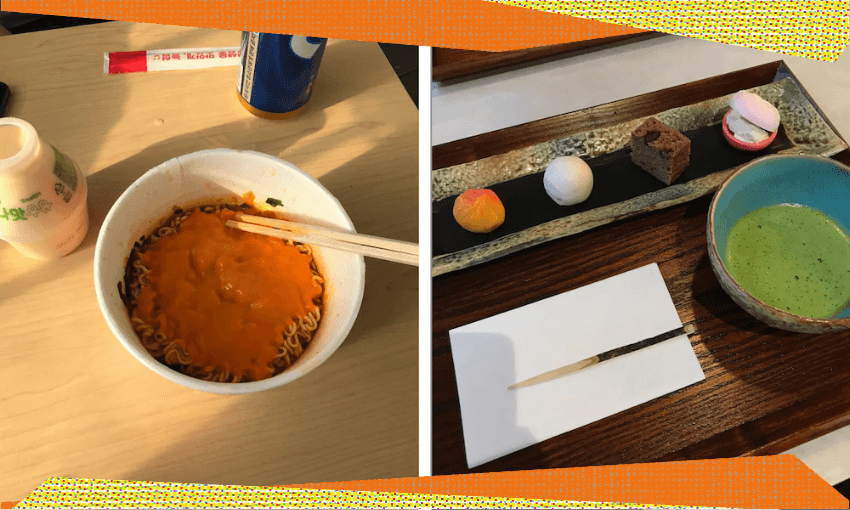Freshly back from an Asian jaunt, Charlotte Muru-Lanning shares some dining experiences she’d love to see adopted in Aotearoa.
This is an excerpt from our weekly food newsletter, The Boil Up.
I’ve been absent from newsletter writing duties for the last two weeks while on a much-anticipated holiday in Japan and South Korea. And so this instalment must reflect the unspoken rule that when we New Zealanders return from anywhere overseas we must turn our newly acquired cosmopolitan lens on our homeland, and immediately become chief critic of what we’re doing wrong, and what, vitally, we could do better.
Does a week and a bit in a foreign country make you some kind of expert in their local quirks, trends, urban design and food culture? Probably not, but we all love to give it a shot. While I was away, I lost count of the number of times I uttered something along the lines of: “Why can’t we have [insert: reliable public transport/ functional fish markets/ underground supermarkets/ conventions around which side you stand on elevators/ heated toilet seats/ 24-7 karaoke/ cute traffic cones/ Uniqlo]?”.
I presume there are unique sets of cultural conditions and a whole lot of historical nuances that make the existence of each of these things possible in these places and not here. But as a blissfully unaware tourist wandering around doing nothing more than observing wide-eyed from the outside, their very existence is striking. It’s hard not to return enlightened, with a long list of suggestions for adding a much-needed dash of mojo to Aotearoa. One less welcome difference I noticed overseas was the novelty of people smoking indoors, even in cafes – but who knows, under our new government, that just might become one of the first sophisticated Japanese idiosyncrasies we embrace here.
Because I’m happy to embrace the stereotype of the newly enlightened tourist, here are four food experiences I had overseas that I would love to see adopted in Aotearoa:
Convenience stores
Let’s get this one out of the way first. At the risk of echoing literally every other returnee from South Korea or Japan, it really wouldn’t hurt us to adopt at least a little bit of their convenience store culture. While convenience store sandwiches in Japan are a thing of inconceivable magnificence, it is the convenience stores in South Korea that really stole my heart.
South Korean convenience stores are designed as third spaces, with tables to sit at and microwaves to prepare your food. There is a resplendent selection of instant ramyeon noodles and accoutrements (eggs, cheese, kimchi, corn – you name it) to suit any star sign, personality and preference. They also sell beer which you can drink while you eat whatever you’ve concocted. They’re open 24/7, are located in almost every apartment complex or street corner, and stock nearly everything you might need to survive. For many reasons – population size, zoning laws, lifestyle differences, a (positive) lack of convenience store conglomerates and alcohol regulations, to name a few – mimicking this type of set-up would be near-impossible in Aotearoa, but a girl can dream, right?
Wagashi afternoon tea
I often think that my deep interest in sweets stems from the fact that I don’t have any kind of sweet tooth at all. That intrigue was part of the reason I was determined to try wagashi, a traditional Japanese confection served with green tea, while on this trip. On a rainy afternoon we decided to make a visit to a hushed wagashi spot in Ginza which came recommended. In contrast to the usual clatter of a New Zealand cafe, this was a serene, almost ceremonial experience. For around NZ$20 we were served two separate courses of tiny bite-sized sweet morsels made from jelly, mochi, bean pastes and wafer, all eaten quietly and slowly. Eating wagashi wasn’t just about getting a sugar hit, but an expression of technique, texture, history, delicateness and seasonality.
A dashi chazuke breakfast spot
Few breakfasts can be as nourishing and soothing as the alchemy that is dashi chazuke. We stumbled across a spot serving the dish, in which dashi broth is poured over a bowl of rice and other toppings to partially submerge them, while finding our way out of the maze that is Shinjuku station in Tōkyo. Despite the shop being located in a busy underground food court, the simplicity of the dashi chazuke served with sides of pickles, cold tofu and roasted green tea was about the most calming way I can imagine starting the day.
Mister Donut
Japan’s first Mister Donut outlet opened in Osaka in 1971, and it has since become the country’s largest and most recognisable doughnut chain. Despite being so entwined with contemporary Japanese doughnut eating, Mister Donut actually has its origins in the US, where it was founded in 1956 out of the dissolution of the partnership behind another doughnut favourite, Dunkin’ Donuts.
What makes a perfect doughnut is very much down to personal preference, but Mister Donut’s whimsical interpretations of the treats won me over on my trip – especially the charmingly named “Angel Cream” (which were just as sublimely squishy and cloud-like as that name suggests) and “Pon De Ring” (a chewy, mochi-like loop. I’d happily watch Krispy Kreme and Dunkin’ Donuts step aside to make room for this superior doughnut chain.
The Spinoff is looking to capture that broad and ever-evolving definition of kai in a new editorial project: What’s eating Aotearoa. If you’re keen to help fund food-focused journalism, make a pledge today.





